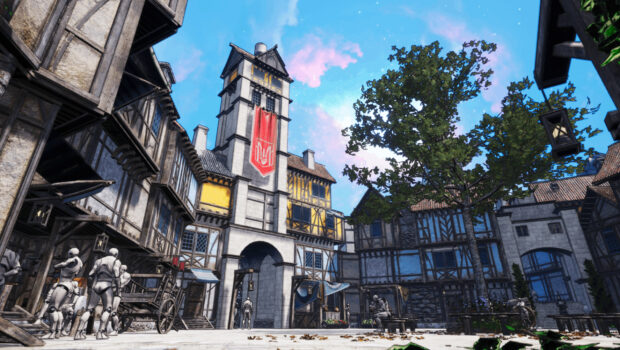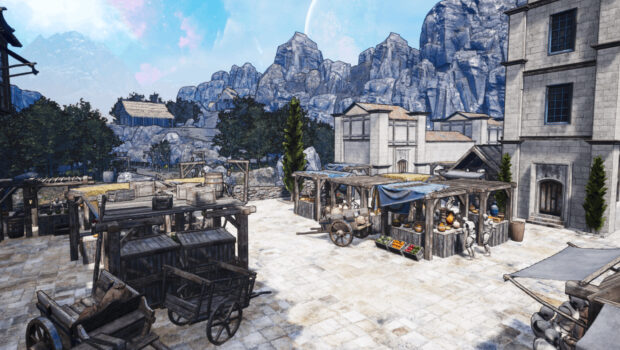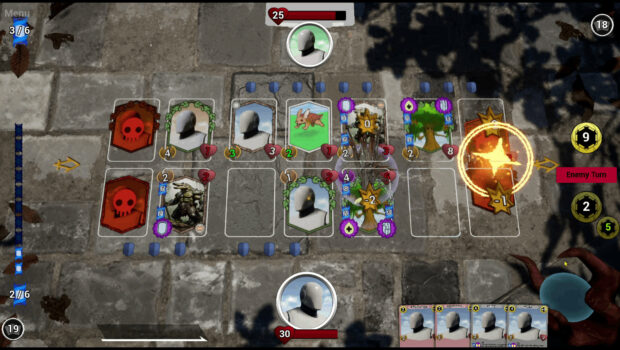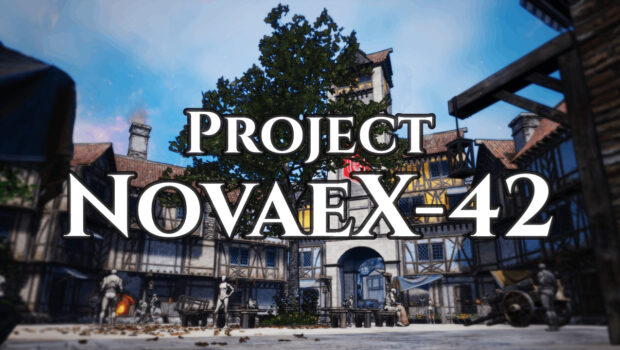Project Introduction
PlotYou wake up after years of imprisonment in the zero-dimensional zone, you will have to work with the empire to suppress the rebel forces in 0D card battles. During the journey you will face situations and make choices that will change the way you see reality, because it’s often not as it seems. This will lead you to decide which side you are on. Will you cooperate with the empire or with the rebels?
Gameplay
Project NovaeX-42 is a mix of card game and first person exploration. The cards are vital both for the battles and exploration.
The battelfield is divided in 3 lanes where Champions and Units fight to damage the opposing leader defended by gates.
Valor is the force used to deploy your army: it’s increased by keeping your troops alive longer and allows you to place stronger cards on the field. Activate abilities and special attacks that can change the fate of the battle using the Charge.
Explore the world to find out informations about the rebels and your lost brother. Use unique abilities to discover new areas.
Mechanics
The main goal of the project was to combine a card-game with an exploration game. Let's go on to analyze the two aspects.
In the battles, we tried to innovate on mechanics common in other card games, like the order of actions, the use of resources and the hand mechanics. For example, The player and the opponent take turns in placing cards and activating abilities, like in chess, to keep the battles fast paced. When all actions are exhausted or both players pass, the Fight Phase is executed and a new Cycle starts.
In Project NovaeX-42 we created the Valor mechanic for placing cards. It is a score that can increase or decrease each Cycle. Valor is not spent to deploy cards on the battlefield, it works instead as a threshold that allows to play cards with a determined Valor Grade. For example: if the player has 5 Valor, he can only play cards that have a Valor Grade of 5 or less.
Your Valor is calculated at the beginning of each cycle depending on the Valor Supply of the cards on the field. Valor isn’t obtained directly from placing cards. For example: If we have on the field 2 cards with a +2 Valor Supply, we have 4 Valor total. If we then play a card with +1 Valor Supply, we will have 5 Valor in the next Cycle if it isn’t destroyed in this Cycle.
Regarding the draw, we decided to replace the simple draw on each Cycle with a system where the players have the possibility of “upgrading” the amount of cards their hand can hold. At the start of a battle players can only hold 4 cards at a time. If they don’t deploy any card they won’t be able to draw at the start of the next Cycle.
There are 2 different types of cards in the game: Units and Champions. The Champions don’t have a Valor requirement to be deployed and when they die they return in hand. In addition to the above we have another important difference. While Units have Active and passive abilities, Champions also have an unique Special Attack and Valor Modifier.
The second one engages once the indicated conditions are met. It allows an increase to the Supply Valor of Champions until they are defeated. However, the bonus obtained is immediately added to the available Valor.
Another difference between Champions and Units concerns their defeat. If for the former they will return to hand and can be used after a turn of standstill; the latter will no longer be usable.
The Charge is the consumable currency for using Active Ability and Special Attacks (both usable only once per Cycle).
Both players start the game with 3 charges out of a maximum of 10. At the start of each Cycle, both armies receive an amount of refill Charges, increasing 1 unit every Cycle. In addition, Charges not consumed in a Cycle are maintained in the next.
Another important aspect is the execution of the Fight Phase. The field is divided into three lanes: left, middle and right. Cards in the same column attack at the same time following the order of execution, which can be from left to right or vice versa. The order of executions alternates each Cycle. The central lane has 3 spaces for cards on each side of the field, while the side lanes have 2 spaces each. This aspect is fundamental for the deployment of each player’s Units, because while Fauna type cards can be placed anywhere, Species cards can be played only in the lane with a Champion of the same color.
With the card-game mechanics covered we move on on the other half of the game. We wanted to introduce the first-person exploration of the world to make it more immersive and in line with the idea of different perspectives. In this section of the game we will not only have to walk or run from one point to another, but we will be able to interact with the environment using in certain situations the Champions obtained. In this prototype we introduced the possibility of destroying walls after obtaining a certain card. In the future the player will have the possibility to find secrets and solve environmental puzzles related to the cards at our disposal.
Currently the deck-building component is absent, but we want to have it in at a later stage of development because we think that customization of the player’s deck, in this case their army, is fundamental to the whole experience.
About Developer
We’re three italian ex-students of AIV (Accademia Italiana Videogiochi) based in Rome and Milan.We decided to keep “alive” our final year project and reach all the goals that we had set ourselves and that we weren’t able to achieve during the academic year.




